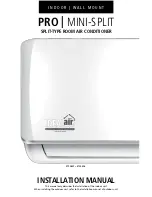
5167531-YIM-J-1019
50
Johnson Controls Ducted Systems
Operation
Cooling sequence of operation
NOTE:
For more in-depth sequence of operation of the Smart
Equipment™ control, refer to the
Smart Equipment™
Controls Sequence of Operation Overview
LIT-
12011950 available from your equipment dealer or
distributor.
For ZR units, a Y1 call for the first stage of cooling is passed to
the Unit Control Board (UCB) which then determines whether
the requested operation is available and if so, which
components to energize. With a Y1 call for first stage cooling
the UCB determines if a first stage cooling output is valid as
long as all safeties and time-delays allow a C1 output for
cooling. The C1 relay on the UCB closes and send 24 volts to
the M1 relay starting the first stage compressor and also
energizing the associated condenser fans. During any call for
fan or cooling the FAN output on the UCB energizes the M3
relay starting the supply fan.
If a Y2 call is present it is passed to the Unit Control Board
(UCB) which then determines whether the requested operation
is available and if so, which components to energize. With a Y2
call for first stage cooling the UCB determines if a second stage
cooling output is valid as long as all safeties and time-delays
allow a C2 output for cooling. The C2 relay on the UCB closes
and send 24v to the M2 contactor starting the second stage
compressor also energizing the associated condenser fans.
During any call for fan or cooling the FAN output on the UCB
will energize the M3 contactor starting the supply fan.
Continuous blower
By setting the room thermostat fan switch to ON, the supply air
blower operates continuously.
Intermittent blower
With the room thermostat fan switch set to AUTO and the
system switch set to either the AUTO or HEAT settings, the
blower is energized whenever a cooling or heating operation is
requested. The blower is energized after any specified delay
associated with the operation.
When energized, the indoor blower has a minimum run time of
30 seconds. Additionally, the indoor blower has a delay of 10
seconds minimum off.
No outdoor air options
When the thermostat calls for the first stage of cooling, the low-
voltage control circuit from R to Y1 and G is completed. The
UCB energizes the economizer (if installed and free cooling is
available) or the first available compressor
*
and the condenser
fans. For first stage cooling, compressor #1 is energized. If
compressor #1 is unavailable, compressor #2 is energized.
After completing the specified fan on delay for cooling, the UCB
energizes the blower motor.
When the thermostat calls for the second stage of cooling, the
low-voltage control circuit from R to Y2 is completed. The
control board energizes the first available compressor. If free
cooling is being used for the first stage of cooling, compressor
#1 is energized. If compressor #1 is active for first stage cooling
or the first compressor is locked-out, compressor #2 is
energized. In free-cooling mode, if the call for the second stage
of cooling continues for 20 minutes, compressor #2 is
energized, provided it has not been locked-out.
If there is an initial call for both stages of cooling, the UCB
delays energizing compressor #2 by 30 seconds in order to
avoid a power rush.
When the thermostat is satisfied, it de-energizes Y1 and Y2. If
the compressors have satisfied their minimum run times, the
compressors and condenser fans are de-energized. Otherwise,
the unit operates each cooling system until the minimum run
times for the compressors have been completed. Upon the final
compressor de-energizing, the blower is stopped following the
elapse of the fan off delay for cooling.
* To be available, a compressor must not be locked-out due to a
high or low-pressure switch or the
Evaporator Low Limit
Sensor (EC1, 2)
detects a temperature below 26°F and the
Anti-Short Cycle Delay (ASCD)
must have elapsed.
Economizer with single enthalpy sensor
When the room thermostat calls for first-stage cooling, the low
voltage control circuit from R to G and Y1 is completed. The
UCB energizes the blower motor (if the fan switch on the room
thermostat is set in the AUTO position) and drives the
economizer dampers from fully closed to their minimum
position. If the enthalpy of the outdoor air is below the setpoint
of the enthalpy controller (previously determined), Y1 energizes
the economizer. The dampers modulates to maintain a constant
supply air temperature as monitored by the discharge air
sensor. If the outdoor air enthalpy is above the setpoint, Y1
energizes compressor #1.
When the thermostat calls for second-stage cooling, the low
voltage control circuit from R to Y2 is completed. The UCB
energizes the first available compressor. If the enthalpy of the
outdoor air is below the setpoint of the enthalpy controller (that
is first stage has energized the economizer), Y2 energizes
compressor #1. If the outdoor air is above the setpoint, Y2
energizes compressor #2.
When the thermostat is satisfied, it de-energizes Y1 and Y2. If
the compressors have satisfied their minimum run times, the
compressors and condenser fans are de-energized. Otherwise,
the unit operates each cooling system until the minimum run
times for the compressors have been completed. Upon the final
compressor de-energizing, the blower is stopped following the
elapse of the fan off delay for cooling, and the economizer
damper goes to the closed position. If the unit is in continuous
fan operation, the economizer damper goes to the minimum
position.
Economizer with dual enthalpy sensors
The operation with the dual enthalpy sensors is identical to the
single sensor except that a second enthalpy sensor is mounted
in the return air. This return air sensor allows the economizer to
choose between outdoor air and return air, whichever has the
lowest enthalpy value, to provide maximum operating
efficiency.
















































